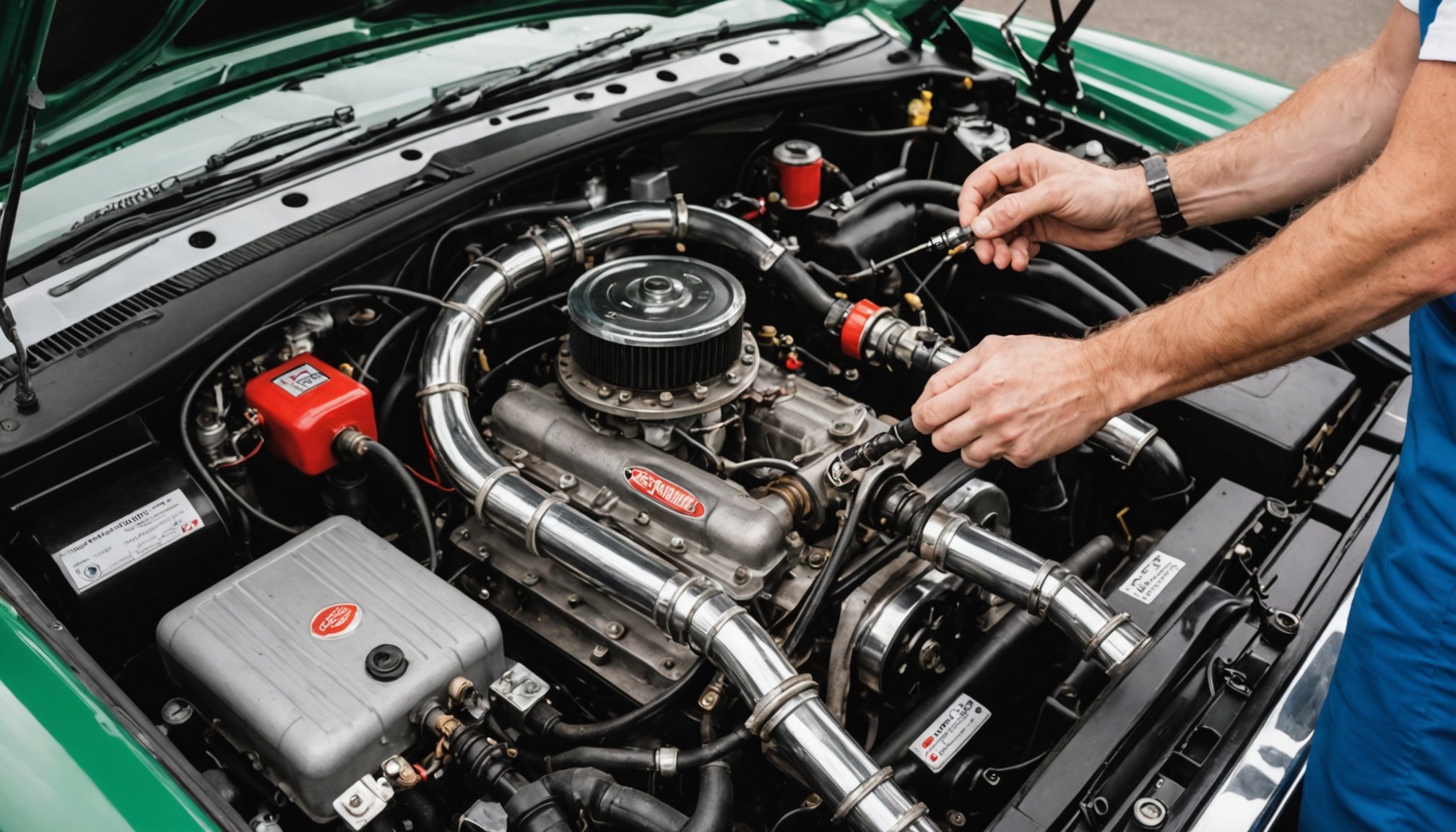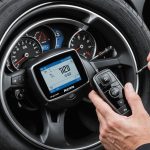Understanding Classic UK Car Fuel Systems
Traditional classic car fuel systems in the UK are fascinating yet intricate networks that provide essential insights for enthusiasts and restorers. These systems primarily rely on fuel delivery mechanics that include several components working in harmony to ensure efficient fuel flow. Key components involve:
- Fuel tank: Stores the fuel.
- Fuel pump: Transfers fuel from the tank to the engine.
- Carburetor or injectors: Mix fuel with air for combustion.
- Fuel lines: Ensure the flow of fuel between components.
- Fuel filters: Remove impurities to protect the engine.
Over time, wear and tear can lead to common issues such as fuel leaks, clogged filters, and pump failures. These problems often stem from aging fuel system components, which can degrade, affecting the overall vehicle performance. Addressing them involves understanding how these components work and recognizing signs of deterioration, such as inconsistent fuel delivery and reduced engine power. Regular inspection and maintenance are crucial. For those passionate about maintaining their vintage cars, familiarising themselves with classic car fuel systems ensures their beloved vehicles continue to run smoothly. Whether maintaining originality or considering upgrades, knowing these fundamentals is invaluable.
Additional reading : Ultimate diy guide: installing aftermarket heated seats in your uk car – a step-by-step approach
Essential Tools for Fuel System Upgrade
Embarking on a fuel system upgrade for a classic car requires the right tools and equipment. With a comprehensive set, enthusiasts and mechanics can tackle the intricate task with confidence and precision.
For any upgrade, a selection of classic car tools is indispensable:
Additional reading : Ultimate handbook: a comprehensive step-by-step guide to polishing and waxing your uk car for paint protection
- Hand tools: Wrenches, screwdrivers, and pliers are must-haves for disassembling and assembling components.
- Specialized equipment: A fuel pressure gauge and a vacuum tester are crucial for diagnosing issues and ensuring optimal performance.
- Fuel line disconnect tools: These facilitate the smooth removal and installation of fuel lines without damage.
When selecting tools, opt for reliable brands known for their quality and durability. Brands such as Snap-on or Craftsman offer a range of mechanic essentials designed specifically for automotive tasks.
Safety cannot be overlooked. Equip yourself with protective gear like safety goggles, gloves, and respiratory masks to safeguard against fuel exposure and debris. Also, ensure that the work area is well-ventilated to prevent harmful fumes from accumulating.
Having these essentials not only streamlines the upgrade process but also enhances safety, ensuring a successful and efficient restoration.
Assessing and Diagnosing Your Current Fuel System
Diagnosing a fuel system effectively starts with a thorough performance assessment. Begin by checking the fuel delivery pressure. Use a pressure gauge to ensure it aligns with manufacturer specifications. Low pressure might indicate issues in the fuel pump or lines.
Listen for unusual sounds when the engine is running. Unfamiliar noises can signal blockages or failing components. Observe fuel consumption closely. A sudden increase might point to clogged fuel filters or injectors. Inspect the fuel tank and lines for leaks or cracks, visible to the naked eye or by smelling fuel odors when parked.
Component wear is identifiable through careful observation. Rubber hoses, for instance, should remain flexible, not brittle. Metal parts like clamps or connections should exhibit no rust or corrosion. Regular inspection mitigates surprises and enhances diagnosis precision.
Troubleshooting fuel issues is essential. For instance, if the engine stalls, consider a blocked filter or failing pump. Remedies might involve component cleaning or replacement. Harness a fuel system diagnosis tool for electronic malfunctions, which highlights areas like injector misfires. Acting promptly upon initial warning signs preserves the system’s integrity and performance.
Components to Upgrade for Improved Performance
Upgrading fuel system components in classic cars offers significant performance benefits. High-performance fuel pumps and filters are at the forefront of these upgrades. They ensure a consistent and efficient fuel delivery mechanics, reducing the likelihood of engine stalls and performance dips.
Carburetors or fuel injectors also benefit from enhancements. By upgrading these, one can achieve a better air-fuel mixture critical for combustion efficiency. This results in improved throttle response and increased horsepower, indispensable aspects for enthusiasts pursuing peak vehicle performance.
Quality hoses and fittings are essential components in these upgrades. Standard hoses can become brittle over time, leading to leaks or fuel delivery issues, which compromise overall system integrity. Investing in reinforced or braided hoses ensures durability and dependability while reducing maintenance frequency.
Another often overlooked component is the fuel lines. Regular steel lines might corrode over time, affecting fuel flow. Opting for stainless steel or anodised aluminium lines can prevent rust and enhance aesthetics.
In conclusion, choosing high-quality aftermarket parts and focusing on essential components will substantially bolster system efficiency and reliability, transforming the driving experience.
Installation Techniques for a Successful Upgrade
Undertaking a fuel system installation in a classic car involves mastering careful upgrade techniques. Initially, gather all necessary components to ensure a smooth process. Begin by draining any old fuel from the system to prevent contamination.
Ensure all fuel lines and connections are securely attached before starting mechanical work. Follow a step-by-step installation process, beginning with the components that connect directly to the engine block. When integrating new components with existing systems, ensure compatibility to avoid future issues.
A reliable method to avoid fuel leaks is using sealant or electric tape on connection joints. Verify that all connections are airtight by testing with a pressure gauge. Additionally, route new fuel lines away from heated engine parts to prevent overheating and related failures.
Prior to starting the engine, conduct a final manual inspection of each installed component for any signs of leaks, loose fittings, or misplaced parts. Re-evaluation is crucial to guarantee system integrity.
Remember to keep detailed records of all changes, including part numbers and installation dates. These notes will serve as a reference for future maintenance, securing the longevity and efficiency of the upgraded fuel system.
Maintenance Tips for Longevity of Upgraded Fuel Systems
Maintaining the longevity of upgraded fuel systems requires regular checks and meticulous care. Performing routine maintenance ensures each component functions optimally and prevents potential issues.
Routine Maintenance Checks: Regularly inspect connections and hoses for any signs of wear or leaks. Conduct scheduled performance assessments using a fuel system diagnosis tool to ensure all parameters remain within manufacturer specifications. This practice helps in identifying troubleshooting fuel issues early.
Seasonal Preparation and Storage: Before long-term storage, drain any fuel left in the system to prevent degradation and clogging. Replenish with fresh fuel and stabilizers as needed to maintain system health during inactive periods. Additionally, inspect fuel delivery mechanics to ensure components such as pumps and filters are ready for seasons of active driving.
Fuel Quality and Additives: Always use high-quality fuel to preserve system integrity. Incorporate fuel additives to prevent deposit formation and to promote efficient combustion. These additives help maintain the cleanliness of fuel system components and optimize overall performance.
Prioritizing these preventive measures ensures your classic car’s upgraded fuel system remains in peak condition, offering reliability and enhancing your driving experience over time.
Legal and Safety Considerations
When upgrading classic car fuel systems, understanding legal requirements is crucial. Compliance with regulations ensures that modifications are both safe and permissible. Familiarize yourself with local laws regarding alterations, as certain components like fuel pumps or carburetors may have specific mandates.
Safety regulations play a vital role in the upgrade process. Adhering to these guidelines helps prevent hazards such as leaks or fires. Use materials that meet safety standards and install devices like flame arrestors where necessary. Proper insulation and fireproof materials help manage risks associated with fuel exposure.
Insurance considerations are another important aspect. Modifications often affect vehicle insurance policies, so it’s necessary to inform your provider about any changes to the fuel system components. This documentation ensures coverage is updated to reflect the vehicle’s current condition and prevents complications in the event of damage or theft.
For additional guidance, consult forums and classic car clubs. These communities offer valuable insights into fuel delivery mechanics and can help navigate regulatory landscapes. By staying informed, you ensure that your classic car upgrades meet all regulatory standards, allowing for worry-free enjoyment of your vehicle.
Finding Reliable Parts Suppliers
Ensuring the longevity and performance of your classic car fuel systems begins with finding dependable suppliers for fuel system components. Trustworthy vendors are essential for sourcing high-quality parts, reducing the risk of malfunctions and enhancing overall vehicle performance.
To identify reputable suppliers, consider their track record in the industry. Seek vendors with a history of supplying components compatible with your specific car and customization needs. Verified customer reviews can provide insights into a supplier’s reputation and reliability. Look for those who offer comprehensive warranties on their components, as this often reflects confidence in their product quality.
Evaluate potential vendors by assessing their available inventory. Ensure they stock essential parts like carburetors, fuel pumps, and quality fittings, which align with your fuel system upgrade tools. Check online resources and automotive forums dedicated to classic cars to gather recommendations and community insights about reliable parts suppliers.
Networking in classic car communities also opens access to collective experiences that can guide your purchasing decisions, ensuring you obtain superior aftermarket components. By leveraging these resources, enthusiasts can build relationships with trusted partners, safeguarding their vehicle’s operational excellence.
Benefits of Upgrading Your Fuel System
Exploring classic car upgrades unveils numerous performance benefits, focusing primarily on improved fuel efficiency and reliability. Upgrading enhances the fuel system’s ability to deliver consistent power, reducing hiccups often caused by aged components. The impact on vehicle performance is immediately noticeable, offering a smoother drive and reduced engine wear.
Performance benefits include increased horsepower and torque, offering better acceleration and responsiveness. Enhanced fuel system components, like high-performance fuel pumps, cater to a more consistent fuel delivery, realizing the full potential of your classic car’s engine. Additionally, improved fuel efficiency signifies not only a financially savvy move but also an environmentally conscious choice, as emissions can decrease with better combustion.
Such upgrades grant a reinvigorated driving experience. Enhancements in fuel system mechanics offer newfound reliability, minimising breakdown risks and ensuring you enjoy your time on the road without frequent hiccups. Whether for daily use or occasional leisure drives, these improvements make genuine contributions to your classic car’s drivability and overall enjoyment.
Transitioning to upgraded parts also supports easier maintenance, minimizing future headaches related to outdated systems while preserving the car’s value. This technical investment pays dividends in pleasure and performance.









